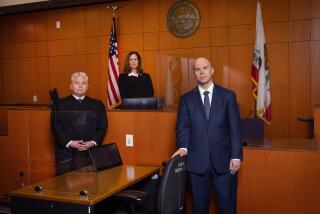Supreme Court cites ‘irreparable harm’ in blocking Prop. 8 trial footage
- Share via
Reporting from Washington — By a 5-4 vote, the U.S. Supreme Court kept in place Wednesday its order blocking video coverage of the trial of California’s Proposition 8, with a conservative majority ruling that defenders of the ban on same-sex marriage would likely face “irreparable harm” if the proceedings were broadcast to the public.
“It would be difficult -- if not impossible -- to reverse the harm of those broadcasts,” the court wrote in an unsigned opinion. The witnesses, including paid experts, could suffer “harassment,” and they “might be less likely to cooperate in any future proceedings.” The high court also faulted U.S. District Judge Vaughn Walker for changing the rules “at the eleventh hour” to “allow the broadcasting of this high-profile trial” that will decide whether gays and lesbians have a right to marry in California.
The unsigned opinion clearly speaks for Chief Justice John G. Roberts Jr., and Justices Antonin Scalia, Clarence Thomas, Anthony M. Kennedy and Samuel A. Alito Jr.
The four liberal justices dissented and accused their colleagues of changing the court’s rules so as to “micromanage” a trial judge.
“The Court today issues an order that will prevent the transmission of proceedings in a nonjury civil case of great public interest to five other federal courthouses,” wrote Justice Stephen G. Breyer. “The majority’s action today is unusual. It grants a stay in order . . . to intervene in a matter of local court administration that it would not (and should not) consider. It cites no precedent for doing so. It identifies no real harm, let alone ‘irreparable harm’. . . . And the public interest weighs in favor of providing access to the courts.”
Justices John Paul Stevens, Ruth Bader Ginsburg and Sonia Sotomayor agreed.
The court’s order means that the trial can be seen only inside the courthouse in San Francisco.
Last week, Walker said the trial would be taped each day and posted on YouTube each evening. On Monday, he revised that plan somewhat and said the video coverage would appear on the court’s website. He also planned to have the proceedings streamed live to several courthouses around the country.
But the high court issued a temporary order Monday morning to stop the video coverage. The extent of the split became apparent Wednesday afternoon when the court issued the 17-page opinion and 10-page dissent.
The majority cited newspaper accounts from the last year to bolster its contention that opponents of same-sex marriage have been “subject to harassment,” including “confrontational phone calls and e-mail messages” and even “death threats.” Under the court’s rules, the justices do not intervene in pending cases unless they are convinced that the appealing side has a strong legal claim as well as evidence of “an irreparable harm” if the court fails to act.
Breyer scoffed at the notion that the witnesses in this case would face harm, because they have gone on television in the past to advocate their views. “They are all experts or advocates who have either already appeared on television or Internet broadcasts, already toured the state advocating a ‘yes’ vote on Proposition 8,” he said.
Advocates for equal marriage rights lambasted the decision. “The Supreme Court just struck a huge blow against transparency and accountability,” said Rick Jacobs, chairman of the Courage Campaign in Los Angeles. “The five conservative justices are enabling Prop. 8 supporters to mask their radical views. This historic trial will remain largely hidden from public view.”
Edward Whelan, a conservative critic of Walker, praised the majority for acting to rebuke him. He accused Walker of seeking a “show trial” in San Francisco to intimidate and embarrass the defenders of California’s voter initiative prohibiting same-sex marriage.
More to Read
Get the L.A. Times Politics newsletter
Deeply reported insights into legislation, politics and policy from Sacramento, Washington and beyond. In your inbox twice per week.
You may occasionally receive promotional content from the Los Angeles Times.











